Review: Nokia N90
Score:
84%
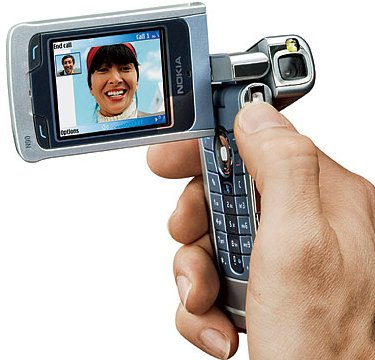 Let's start at the very outside. A quick word about the N90's packaging, which is something that is not normally mentioned. It’s gorgeous. The phone itself is on display in the blister pack, with all the features that Nokia are proud of highlighted on the rear of the box. There’s a twin opening feature, and it makes the first few moments of the ‘user experience’ very nice.
Let's start at the very outside. A quick word about the N90's packaging, which is something that is not normally mentioned. It’s gorgeous. The phone itself is on display in the blister pack, with all the features that Nokia are proud of highlighted on the rear of the box. There’s a twin opening feature, and it makes the first few moments of the ‘user experience’ very nice.
The first thing that strikes you about the N90 once it’s in your hand is the sheer size of the unit. Sure it packs a lot into the frame, but compared to the svelte forms of some of the ‘budget’ phones you can get on contract for free nowadays, the N90 better have something to back up its bulk. Luckily, it does. The big selling point of the N90 is that it’s a camera phone. Now I know that this term has been thrown about a lot in the last few years, but the N90 is probably the first device to really live up to the promise.
The optics are the most prominent feature of this focus on being a camera (and yes, the pun was intended). With Carl Zeiss optics in the phone and being mentioned in every advert and press release, Nokia are rightly making a big thing of this. What’s great, from an end user point of view, is that all the powered auto-focus equipment operates without any user interaction – that’s why it’s called Auto-focus – and the resulting pictures are some of the best from a 'phone'.
But what gets people most about the N90 isn’t the fancy lens, but the fact that it is a transformer. While you might be giggling at visions of little toy cars turning into robots, you’re pretty close with the N90. Spinning the camera barrel while closed gives you something very close to a regular camera. Flip up the screen and you can switch to ‘handheld’ mode, which is primarily for video but also works as a good full screen camera mode as well. Finally whip everything back into place and you have a fully featured flip phone.
It makes for a very tactile phone, one that you are more than happy to lift out and just open and close all the time. I find myself idly spinning the camera barrel around. What I did find was a problem with the design when trying to put it into my trouser pockets. If I put the phone in with the camera barrel going in first, it spins round a touch and this makes it really awkward to get in the pocket. Invariably it would be lifted out and turned over 180 degrees. The second problem is the battery cover. I’m glad I’m not alone in this – it’s virtually impossible to get off the device due to the incredibly tight fit. Once it was open, I resorted to a tiny tab of sticky tape to make sure I could get back into it again while reviewing it. It might not be as much of a concern to people using it as their only phone, but it lets down the overall “first few minutes” experience.
Taking Pictures
Being a camera phone, you’d expect the N90 to deliver some good pictures. Running from 640x480 up to 1600x1200 the pictures are leaps ahead of what we had from the first generation camera phones. The N90’s Carl Zeiss lenses are an improvement over the plastic lenses you’re used to. Of course that lens technology is improving as well, and the N70 can give the N90 a good run in terms of picture quality (with average subjects and landscapes), but there’s a clear winner when comparing shots from these two phones. Compared to a regular digital camera, the N90 still feels a little bit lacking, but the performance is definitely in the “more than good enough” category.
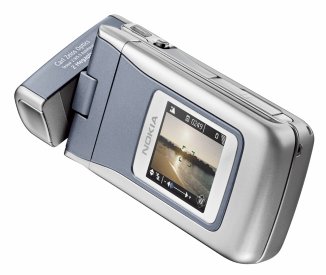 What’s more interesting for me is the totally closed ‘transformer’ mode for taking pictures, because at that point there’s no indication that you have a phone. The outside display turns into a viewfinder, with a button on the top of the long spine to take pictures and a secondary cursor for you to move around the menu system. I’ve handed this to people to take pictures and they’ve had no problem working out what to do. It’s only when it rings and I open the clamshell that they do a double take.
What’s more interesting for me is the totally closed ‘transformer’ mode for taking pictures, because at that point there’s no indication that you have a phone. The outside display turns into a viewfinder, with a button on the top of the long spine to take pictures and a secondary cursor for you to move around the menu system. I’ve handed this to people to take pictures and they’ve had no problem working out what to do. It’s only when it rings and I open the clamshell that they do a double take.
The other main addition to the N90 over a regular camera phone is the auto-focus in the lens system. This makes very small adjustments to the lens distance, and thus to the focusing of your pictures. As mentioned, all this is invisible to the end-user. You really notice it on macro shots, where you are taking very close up pictures, and the benefits get less and less as your subject gets further and further away. The lens system has resulted in one lost feature from the device, the vibrate function for calls and messages. The official answer is that 'this would cause too much internal vibration and damage the lens system', although this really doesn't ring true to me.
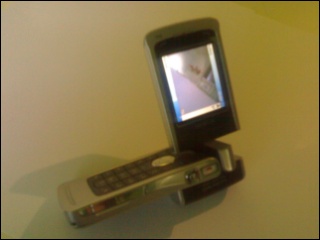 The second mode is primarily designed for video capturing, but it’s actually more ergonomic on the controls to take pictures in this mode as well, placing the cursor and camera buttons just by your thumb in a natural grip. You also have access to the two traditional Series 60 soft keys next to the screen. It’s worth pointing out that someone’s head is screwed on straight at Nokia, because the soft keys are actually duplicated. One set above the screen for this camera mode, and a second set above the number pad (below the screen on the bottom half of the clamshell) in flip open mode.
The second mode is primarily designed for video capturing, but it’s actually more ergonomic on the controls to take pictures in this mode as well, placing the cursor and camera buttons just by your thumb in a natural grip. You also have access to the two traditional Series 60 soft keys next to the screen. It’s worth pointing out that someone’s head is screwed on straight at Nokia, because the soft keys are actually duplicated. One set above the screen for this camera mode, and a second set above the number pad (below the screen on the bottom half of the clamshell) in flip open mode.
The video camera functionality is definitely one of the strengths of the N90. The 352 by 288, 15 frames per second output is quite acceptable for ad-hoc home movies, with pixellation only apparent when blown up on a large screen and with the frame rate only being a problem when panning around quickly. Everyone knows what you can do with your camera, but if you take the N90 and then look at something like the Video iPod, you'll see that the N90 is a perfect (and cheap) tool to create a video suitable for delivery over iTunes to the iPod. And this alone makes the N90 a tempting phone to carry for bloggers, and it wouldn’t surprise me to see a major news event captured on this smartphone featured on the news in 2006.
A final note on the construction. Nokia aren’t known for their flip phones, and the USA (as opposed to Europe) generally prefers this form factor. Nokia’s PR knows this and the N90 is getting a huge push in advertising in the USA because of this. This might be the first Nokia smartphone to break the US market. It’s also likely to be the first phone that I break. Because of the size of the unit, and all the transformer modes, it’s fallen out of my hands three times in the last month. It’s probably just me, but there may be a worry that with all the moving parts and modes where bits stick out, one bad fall and the N90 will be a Nokia jigsaw.
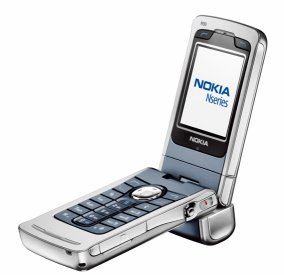 Onto The Phone
Onto The Phone
Okay, for the mobile phone geeks, this is Series 60 version 2 feature pack 3, running Symbian OS 8.1a.
What everyone is going to notice in phone mode is the high-resolution screen. Rather than the old Series 60 standard of 176x208 pixels, the N90 has a 256K colour screen that runs at 352x416 pixels. That’s exactly double the number of pixels in each direction. So for (built-in and third party) applications that aren’t 'screen size aware' Nokia simply double up the pixels on the screen in a compatibility mode where each theoretical pixel is actually a group of 2x2 pixels, thus replicating the original 176x208 sized screen.
These extra pixels are used to good effect in the presentation of the built-in user interface elements. We have smoother looking fonts for buttons and in the menus. Having more pixels in the same physical dimensions as previous screens makes it much easier to read from the screen, and less of a strain if you use the phone for extended periods (think web browsing or ebook reading).
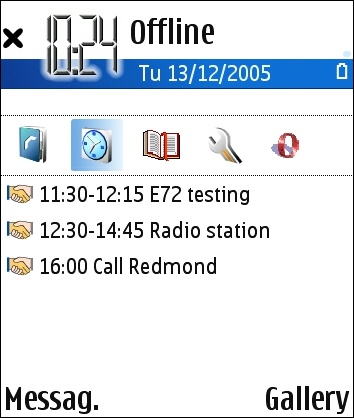
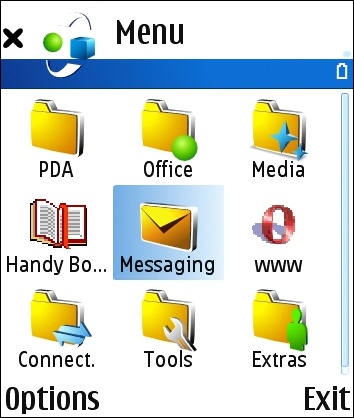
What we don’t have in the majority of applications is any sensible use of the extra space. My biggest problem in the messaging applications is that a paltry maximum of three messages can be seen at any one time. Which is fine for SMS, but when you have an email address that even picks up a little bit of spam, the interface gets incredibly cumbersome when scrolling through messages. It’s unfortunate that some of the key applications that come with the N90 don't really make more use of the high resolution screen. Opera is probably the biggest let-down here, as their small screen rendering could do wonders with the 352 pixel width screen.
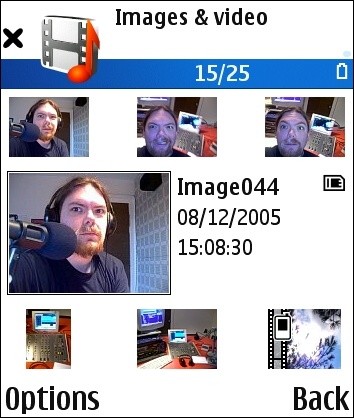

Where you do notice the extra pixels is naturally in the multimedia applications. The new Gallery application shows a ribbon of all your pictures and videos in a scrolling thumbnail mode. Those looking for the original menu style strip, it’s still there, so relax. Each thumbnail is generated when an entry is first shown on the screen, and this can lead to a delay when looking at new pictures as each thumbnail is generated. When you first move to a picture in the ribbon, you’re seeing a zoom on the thumbnail, not the image. It’s only when you click again do you get to the real, high definition image. Although initial thumbnail generation is slow, if you give the smartphone time to build them up, you'll find Gallery more fully stocked and faster the next time you use it.
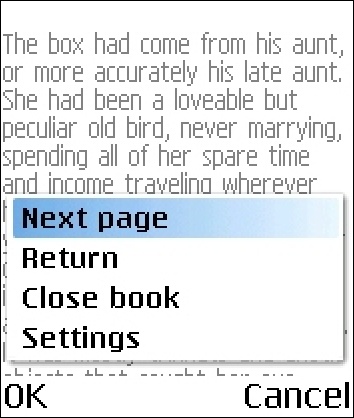 Let’s not forget that the N90 is also a standard Series 60 device as well, which means there’s a huge range of built in applications that have been slowly polished over the years, and now they all take account of the high-resolution screen (to some degree). The Calendar application is now genuinely useable for a full day's worth of appointments. Notes and To-Do list, while benefiting from the better presentation, are still woefully lacking in any tools (such as category support) to make them as useful as their counterparts on other PDA and smartphone platforms.
Let’s not forget that the N90 is also a standard Series 60 device as well, which means there’s a huge range of built in applications that have been slowly polished over the years, and now they all take account of the high-resolution screen (to some degree). The Calendar application is now genuinely useable for a full day's worth of appointments. Notes and To-Do list, while benefiting from the better presentation, are still woefully lacking in any tools (such as category support) to make them as useful as their counterparts on other PDA and smartphone platforms.
There's an Adobe PDF viewer application (useful for those attachments you’ll be sent by the office) and the Quickoffice suite that provides you with a Microsoft Office compatible word processor and spreadsheet application, along with a PowerPoint slide viewer. These are welcome additions and extend the functionality of Symbian OS – we’ve looked at them previously – but again it would be nice to see these running in full screen resolution and not just compatibility mode.
Finally, one quick note about the Data Transfer application that copies Contacts, Calendar and Gallery data between two Series 60 phones via Bluetooth. Providing this makes upgrading between devices incredibly easy for the end user, and ends the absolute reliance on PC Suite that previous upgrades would have needed. Speaking of PC Suite (which we’ll look at in more depth in a later review), it’s now generally pretty stable and easy to use. Whereas before it was always perceived as a rather geeky solution (“Why would you want to plug your phone into your PC?”), it’s now well targeted and rather useful for the end-user.
Summary
The N90, right now, is probably the most feature-packed Series 60 smartphone, and it will remain that way until the recently announced devices for the first half of 2006 make an appearance in the retail channels. It really does show how far the cameraphone/smartphone genre has come in the last few years. It’s also a call to developers to make sure that they’re following recommended practice when designing applications, i.e. that they're not hard coding interfaces to use a specific screen size. The N90 is the first phone to break out of the standard form factor in terms of screen resolution and fonts available. This is a challenge going forward for developers, Nokia and Symbian, but it’s easily surmounted with good communication.
To sum up, the N90 is Nokia’s first true cameraphone to focus on the camera, and it’s all the better for it. Yes, the unit has a number of quirks in the design, but the software, the operation and general polish of Series 60 continues, and makes the N90 the high-end phone of the moment in both Nokia’s N range and in terms of smartphones in general. It might be marketed with the camera as its killer feature, but with Series 60 it covers all the bases, and covers them well. Right now, there’s no solid reason to not look very, very seriously at the N90.
Reviewed by Ewan Spence at
